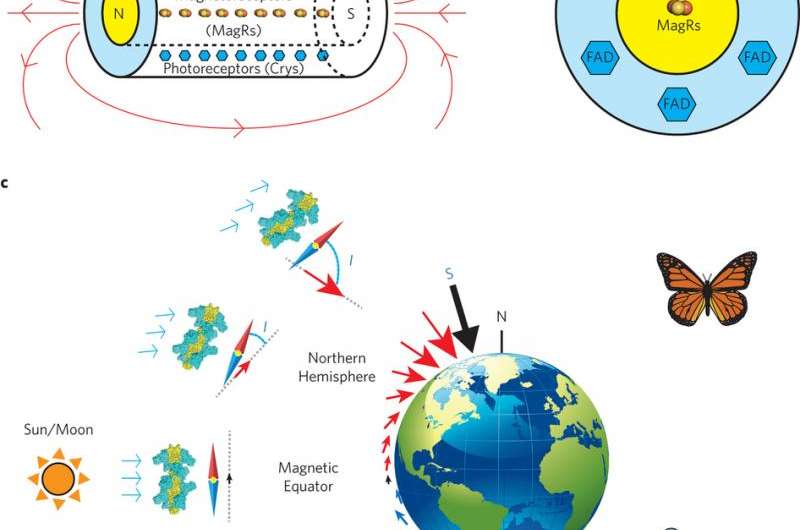November 17, 2015 report
Protein complex may help explain magnetic sensing in insects and animals

(Phys.org)—A team of researchers with Peking University, the Chinese Academy of Sciences and Tsinghua University has identified a protein that aligns with a magnetic field when polymerized and coupled with another well known protein. In their paper published in the journal Nature Materials, the researchers suggest the protein complex may be the means by which many insects and animals orient themselves using the Earth's magnetic field.
Scientists have studied animals, such as homing pigeons, that are able to use the Earth's magnetic field to orient themselves, for quite some time, but have yet to uncover the actual mechanism behind the ability. In this new work, the researchers believe they may have found the underlying chemistry, even if they have not been able to connect it directly to magnetic sensing.
The researchers picked up where other research left off—with a light sensing protein called cryptochrome that has been identified in the eyes of some animals–some have suggested it may play a part in magnetic sensing. But, because the protein is not sensitive to magnetism, the team reasoned that it might team up with another protein that is. To find out, they searched the genome of a fruit fly that is known to sense magnetic fields, until they found a gene responsible for creating a protein (called CG8198, which they renamed to MagR) that would respond to iron. They then polymerized that protein and coupled it with cryptochrome and then watched, using a microscope, what happened when iron objects were brought near. The team reports that the protein complex lined up like a needle in a compass.
The researchers acknowledge that their findings do not prove that the protein complex is responsible for magnetic sensing, but suggest it seems possible—if the protein complex lined up inside the eye of a pigeon, for example, it could cause a reaction with other proteins or even cells, that in turn could impact nerve cells. They note that the protein complex exists in many organisms that have demonstrated magnetic sensing, including in the eyes of pigeons—they are calling on the research community to conduct other studies to determine if removing the complex from magnetic sensing insects or animals, causes them to lose their magnetic sensing abilities, which could indirectly prove that they form the basis for the ability. If such efforts prove fruitful, then the next logical step would be to study the complex further as it exists inside living animals to determine exactly how it works.
More information: Siying Qin et al. A magnetic protein biocompass, Nature Materials (2015). DOI: 10.1038/nmat4484
Abstract
The notion that animals can detect the Earth's magnetic field was once ridiculed, but is now well established. Yet the biological nature of such magnetosensing phenomenon remains unknown. Here, we report a putative magnetic receptor (Drosophila CG8198, here named MagR) and a multimeric magnetosensing rod-like protein complex, identified by theoretical postulation and genome-wide screening, and validated with cellular, biochemical, structural and biophysical methods. The magnetosensing complex consists of the identified putative magnetoreceptor and known magnetoreception-related photoreceptor cryptochromes (Cry), has the attributes of both Cry- and iron-based systems, and exhibits spontaneous alignment in magnetic fields, including that of the Earth. Such a protein complex may form the basis of magnetoreception in animals, and may lead to applications across multiple fields.
Journal information: Nature Materials
© 2015 Phys.org




















